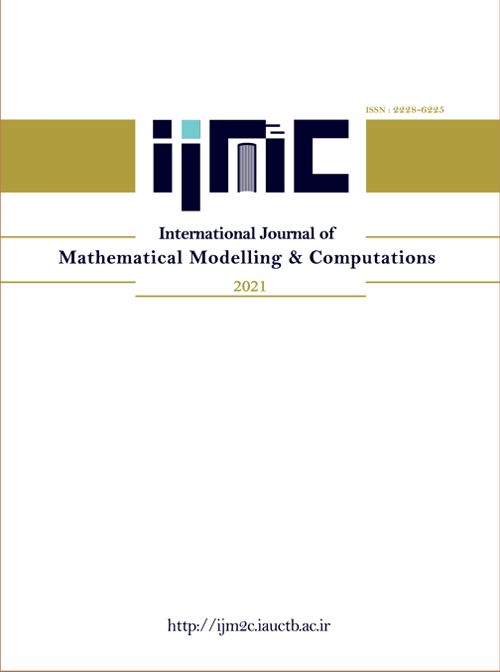فهرست مطالب

مجله بین المللی محاسبات و مدل سازی ریاضی
سال دوازدهم شماره 1 (Winter 2022)
- تاریخ انتشار: 1401/05/26
- تعداد عناوین: 6
-
-
Pages 1-14
In this paper, we present a new numerical technique based on Block-pulse functions to solve two-dimensional Volterra-Fredholm integral equations of the second kind. To produce Block-pulse functions, the orthogonal Legendre polynomials is used. Furthermore, operational matrix is applied to convert two-dimensional Volterra-Fredholm integral equations to a linear algebraic system. The convergence analysis of the new method is discussed. Finally, some numerical examples are given to confirm the applicability and efficiency of the new method for solving two-dimensional Volterra-Fredholm integral equations of the second kind.
Keywords: Volterra-Fredholm integral equations, Block-pulse functions, Operational matrix, legendre polynomials -
Pages 15-25
In this paper, a two layer recurrent neural network (RNN) is shown for solving nonsmooth pseudoconvex optimization . First it is proved that the equilibrium point of the proposed neural network (NN) is equivalent to the optimal solution of the orginal optimization problem. Then, it is proved that the state of the proposed neural network is stable in the sense of Lyapunov, and convergent to an exact optimal solution of the original optimization. Finally two examples are given to illustrate the effectiveness of the proposed neural network.
Keywords: Recurrent neural network, nonsmooth pseudoconvex, Optimization, Global convergence -
Pages 27-35
Tensors as vector fields structures and manifolds as great geometrical-topological structures have many applications in the fields of big data analysis. Types of norms, metrics and scalable structures have been defined from various aspects. Nowadays, the hybrid methods between tensorial algorithms and manifold learning (MaL) methods have been attracted some attention. In image and signal processing, from image recovery to face recognition, these methods have appeared very excellent. According to our experiments by MATLAB R2021a, the hybrid algorithms are powerful other than algorithms based on the efficient popular parameters.
Keywords: Image recovery, Image recognition, manifold Learning, Tensors, Tensor completion -
Pages 37-49
Since December 2019 that the coronavirus pandemic (COVID-19) has hit the world, with over 13 million cases recorded, only a little above 4.67 percent of the cases have been recorded in the continent of Africa. The percentage of cases in Africa rose significantly from 2 percent in the month of May 2020 to above 4.67 percent by the end of July 15, 2020. This rapid increase in the percentage indicates a need to study the transmission, control strategy, and dynamics of COVID-19 in Africa. In this study, a nonlinear mathematical model to investigate the impact of asymptomatic cases on the transmission dynamics of COVID-19 in Africa is proposed. The model is analyzed, the reproduction number is obtained, the local and the global asymptotic stability of the equilibria were established. We investigate the existence of backward bifurcation and we present the numerical simulations to verify our theoretical results. The study shows that the reproduction number is a decreasing function of detection rate and as the rate of re-infection increases, both the asymptomatic and symptomatic cases rise significantly. The results also indicate that repeated and increase testing to detect people living with the disease will be very effective in containing and reducing the burden of COVID-19 in Africa.
Keywords: Coronavirus, COVID-19, Reproduction Number, re-infections, asymptomatic case detection -
Pages 51-60
A new class of exact solutions of the Einstein-Maxwell system is found in closed form for a static spherically symmetric anisotropic star in the presence of an electric field by generalizing earlier approaches. The field equations are integrated by specifying one of the gravitational potentials, the anisotropic factor and electric field which are physically reasonable. We demonstrate that it is possible to obtain a more general class of solutions to the Einstein-Maxwell system in the form of series with anisotropic matter. For specific parameter values it is possible to find new exact models for the Einstein-Maxwell system in terms of elementary functions from the general series solution. Our results contain particular solutions found previously including models of Thirukkanesh and Maharaj (2009) and Komathiraj and Maharaj (2007) charged relativistic models.
Keywords: Einstein-Maxwell system, exact solutions, relativistic astrophysics, anisotropic charged star -
Pages 61-77
In this paper we introduce concepts of pseudo-triangular entropy as a supplement measure of uncertainty in the uncertain portfolio optimization. We first prove that logarithm entropy and triangular entropy for uncertain variables sometimes may fail to measure the uncertainty of an uncertain variable. Then, we propose a definition of pseudo-triangular entropy as a supplement measure to characterize the uncertainty of uncertain variables and we derive its mathematical properties. We also give a formula to calculate the pseudo-triangular entropy of uncertain variables via inverse uncertainty distribution. Moreover, we use the pseudo-triangular entropy to characterize portfolio risk and establish some uncertain portfolio optimization models based on different types of entropy. A genetic algorithm (GA) is implemented in MATLAB software to solve the corresponding problem. Numerical results show that pseudo-triangular entropy as a quantifier of portfolio risk outperforms logarithm entropy and triangular entropy in the uncertain portfolio optimization.
Keywords: Entropy, Uncertain variable, Uncertainty theory, Pseudo-triangular entropy, uncertain portfolio optimization

